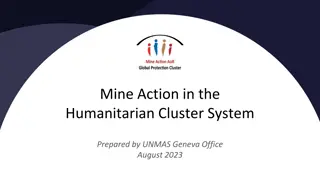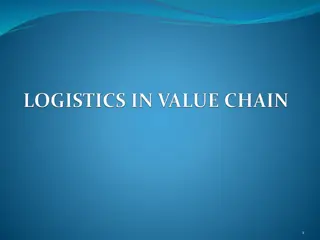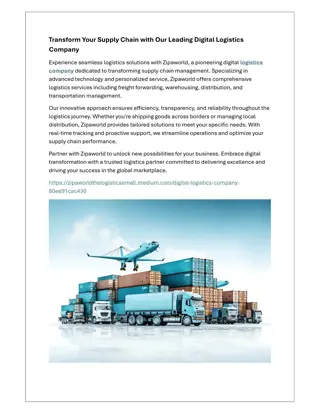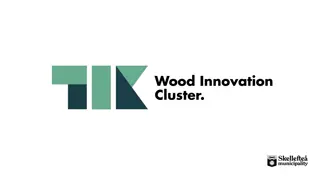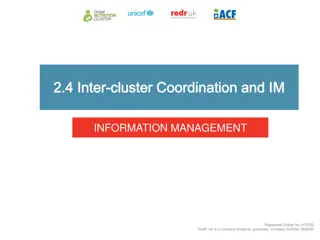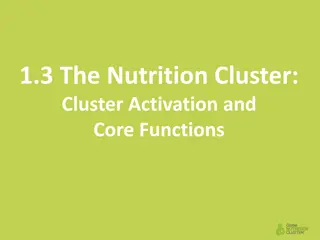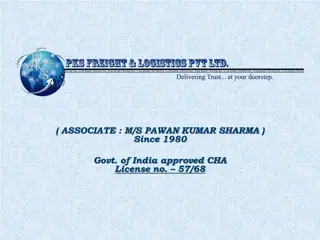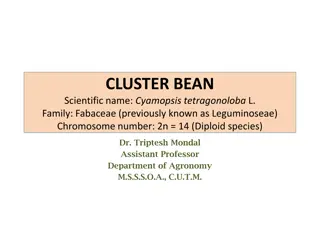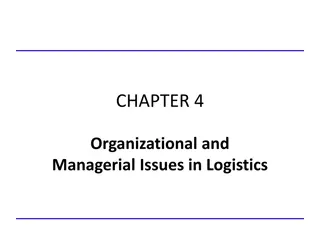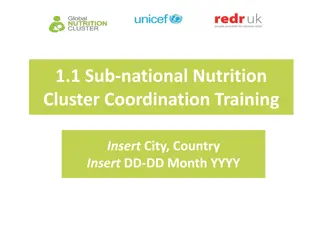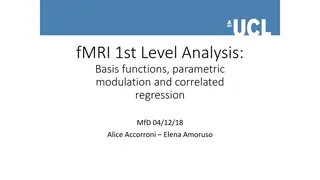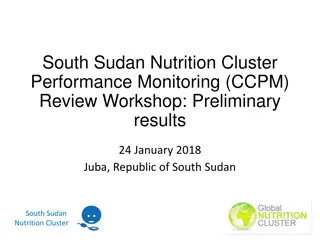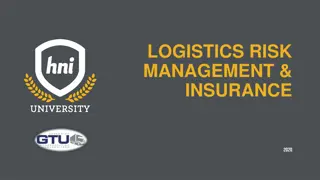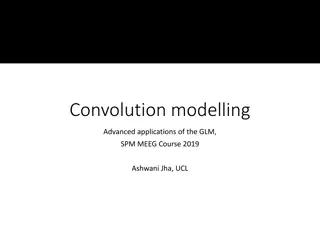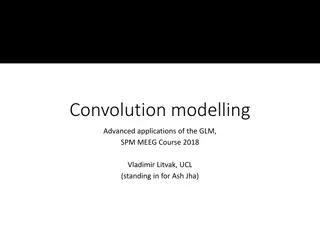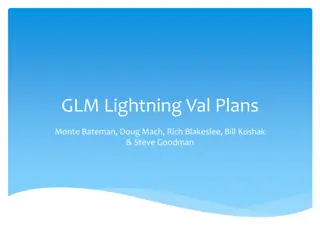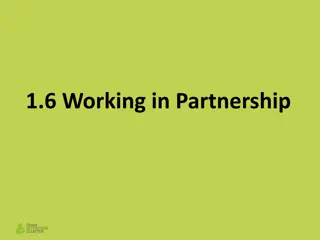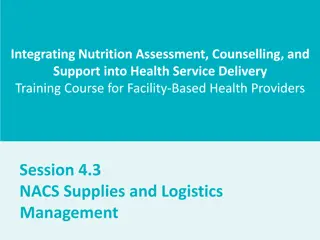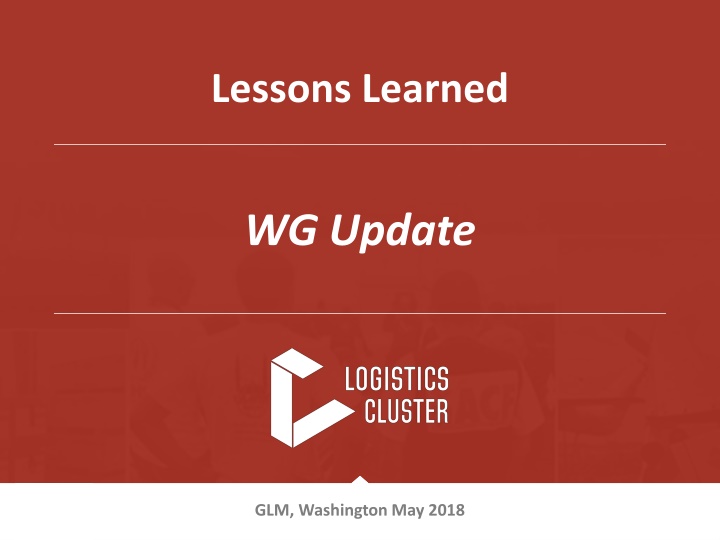
Lessons Learned WG Activities and IASC Cluster Functions in Humanitarian Response
Discover the valuable insights from Lessons Learned WG activities in 2018, including after-action monitoring and tracking tables. Learn about the key functions of IASC clusters in informing strategic decisions, planning, advocacy, and preparedness for humanitarian response coordination.
Uploaded on | 2 Views
Download Presentation

Please find below an Image/Link to download the presentation.
The content on the website is provided AS IS for your information and personal use only. It may not be sold, licensed, or shared on other websites without obtaining consent from the author. If you encounter any issues during the download, it is possible that the publisher has removed the file from their server.
You are allowed to download the files provided on this website for personal or commercial use, subject to the condition that they are used lawfully. All files are the property of their respective owners.
The content on the website is provided AS IS for your information and personal use only. It may not be sold, licensed, or shared on other websites without obtaining consent from the author.
E N D
Presentation Transcript
Lessons Learned WG Update v v OCTOBER 2013 GLM, Washington May 2018
Content v WG activities 2018 Lessons Learned After Action Monitoring Purpose Tracking table Dashboard v
Activities 2018 Learning from Lessons Methodology Lessons Learned Tracking table Concluded: Strengthen: Adding a management developed Ethiopia and Haiti After-action monitoring response Upcoming: South Sudan Bangladesh Services implemented system developed Including Quality Team Dashboard for learning from start and monitoring After-action developed and monitored by partners Impact assessment THW, ACF, Goal, UNICEF + GLC 4 calls in 2018 (till May)
After-action monitoring - Tracking table Purpose: to track progress and document learning and actions taken Use: 1. 2. 3. Understand best practices, Identify where more action needs to be done Help track and document performance (and develop KPIs) for key functional cluster areas Lessons and actions are shown by: Global/local level Country IASC core function (including sub-category) The responsible technical area under who s responsibility the action lies Status of the action The table is being RETROACTIVELY filled Retroactive management response will be filled before next GLM Future: progress updated on a 3 months basis
IASC Cluster Functions Informing strategic decision- making Planning and strategy development Supporting service delivery Preparing needs assessments and analysis of gaps to inform the setting of priorities, Identifying and finding solutions for (emerging) gaps, obstacles, duplication and cross-cutting issues Formulating priorities on the basis of analysis Developing sectoral plans, objectives and indicators that directly support realization of the overall response strategic objectives Applying and adhering to common standards and guidelines Clarifying funding needs, helping to set priorities, and agreeing cluster contributions to the HC s humanitarian funding proposals Providing a platform that ensures service delivery is driven by the Humanitarian Response Plan and strategic priorities Developing mechanisms to eliminate duplication of service delivery Monitoring and reporting on performance Monitoring and reporting on activities and needs, Measuring progress against the cluster strategy and agreed results Recommending corrective action where necessary Preparedness Advocacy Contingency planning/preparedness for recurrent disasters whenever feasible and relevant, Building national and local actors capacity Identifying concerns, and contributing key information and messages to HC and HCT messaging and action, Undertaking advocacy on behalf of the cluster, cluster members, and affected people
DASHBOARD LINK TO DASHBOARD RANDOM INFORMATION
Tracking table (1) Date of recommen dation Type of recommendation Country/GLC Lesson/Best Practice Recommendation Ensure a global early warning system is closely followed and adhered to, to ensure early engagement and deployment of a Logistics Cluster team. Proactively approach key partners and actors on the ground to advocate for early activation or enhanced coordination in slow onset emergencies. There is a need for improvement of timely and appropriate activation or identification of alternative ways of operating to address gaps in slow-onset emergencies Ethiopia Jan-18 Lesson There is a need for improvement of timely and appropriate activation or identification of alternative ways of operating to address gaps in slow-onset emergencies Explore the benefits of establishing a national logistics cluster working group, which could be augmented during periods of heightened needs. Ethiopia Jan-18 Lesson Consider using gaps analysis in complicated and large scale emergencies as a standard practice. Ensure the gaps analysis clearly states which gaps are within or outside the scope of Logistics Cluster operations. Ethiopia Jan-18 Continued - appropriate activation Best practice Consider using gaps analysis in complicated and large scale emergencies as a standard practice. Ensure the gaps analysis clearly states which gaps are within or outside the scope of Logistics Cluster operations. Ethiopia Jan-18 Continued - appropriate activation Best practice Create a workshop for partners on the Logistics Cluster s scope of work, and on expectations from the cluster team and from partners. Ethiopia Jan-18 Continued - appropriate activation Lesson To manage expectations and clarify the role and scope of the Cluster work engage and liase with partners regularly and throughout the operation. Hold meetings with different agendas with different type of stakeholders, not to mix objectives (coordination, donor liasion etc) There is a need for clear messaging about the role of the Cluster, the scope of work, and to manage stakeholders - including targeted meetings Ethiopia Jan-18 Lesson Tools develop for information on the national supply chain was very helpful and can be used in other operations Share tools developed for national supply chain transparency and reporting with other global operations Ethiopia Jan-18 Best practice The regular dissemination of information management products through dedicated mailing lists proved to be beneficial, and could be used in other operations to promote usage of products by diverse partners. Ethiopia Jan-18 Best practice Use mailing lists in addition to other IM dissemination strategies
Tracking table (2) Management response (RETROACTIVELY CREATED) Action to be taken Responsible Area to follow up Status Recommendation partly accepted - a procedure can be developed but it needs to be flexible taking into account the local context of the operation Develop a GLC procedure and criteria for when to start engaging more actively in a country/region to assess logistics gaps. f. Logistics Coordination b. Response/action pending Country level TBD TBD f. Logistics Coordination b. Response/action pending Conduct a desk review of existing tools/checklists available for assessing the supply challenges in a humanitarian emergency. Develop a cluster set of checklists and guidance for doing a quick but also a more thorough gap analysis and how to monitor progress in the gap filling. Linking the gap analysis with actions which could be done in preparedness and throughout to the exit strategy handling of a continued gap. Develop gap analysis guidance and reporting material for it to be available when relevant f. Logistics Coordination c. Response/action in progress Develop gap analysis guidance and reporting material for it to be available when relevant Develop monitoring guidance and tools for the gap filling f. Logistics Coordination b. Response/action pending This can be considered in a specific operation at country level share lesson d. Information Management d. Response/action completed Include stakeholder management in staff trainings and LRTs Include stakeholder management in staff trainings and LRTs f. Logistics Coordination c. Response/action in progress Develop a menu of tools available linked to what kind of gap they fill for easy adoption or inspiration in other emergencies as feasible. Eg. shipping overview in congested ports Recommendation accepted d. Information Management b. Response/action pending This is a standard practice in most operations but the importance of it is recognised. no action h. Management a. No response/action required
Tracking table (3) Status Cluster functions IASC Cluster sub-functions Level 1.1 Needs assessment, analysis and prioritisation b. Response/action pending 1. Informing strategic decision-making Global 5.1 Preparedness, contingency planning, risk assessment, training b. Response/action pending 5. Preparedness, contingency planning Country 1.1 Needs assessment, analysis and prioritisation c. Response/action in progress 1. Informing strategic decision-making Global 4.1 Monitoring and reporting of results (objectives, KPIs, sitreps, reports, LL) b. Response/action pending 4. Monitoring and reporting Global 2.2 Partnership (ensure efficiency of service delivery, map and leverage local capacity, proactive engagement) d. Response/action completed 2. Supporting service delivery Country c. Response/action in progress 7. Global level support 7.2 Technical support (eg training) Global 2.3 Information Management - Access to, quality of, and timeliness of information, and addressing gaps b. Response/action pending 2. Supporting service delivery Global a. No response/action required

